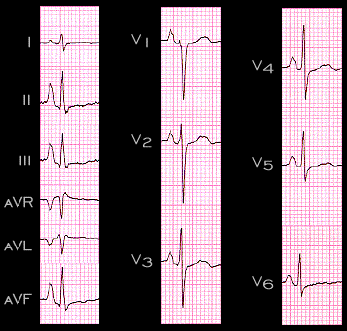
There are several situations in which sinus P waves (i.e. P waves reflecting atrial depolarization originating in the sino-atrial node) appear abnormal because their amplitude, shape and/or duration are beyond normal limits. In patients with chronic obstructive pulmonary disease (COPD), the P waves often have a characteristic shape referred to as "P Pulmonale". This is illustrated here. The ECG is from a patient with severe emphysema. The P wave is 4mm tall in lead II, 3mm tall in leads III and aVF and 1mm tall in Lead I. Its spatial vector in the frontal plane is directed inferiorly with an axis of about +85 degrees. Note also the tall initial i.e.right atrial component of the P wave in leads V1 and V2.
